
Are you a landscaping business owner struggling to attract new customers online? In this ultimate guide to SEO for landscaping, I’ll show you how to improve your online visibility and drive more leads and sales through search engines like Google.
No prior experience with SEO is necessary! These easy-to-follow tips with plenty of examples will have you well on your way to attracting more customers and growing your business.
1. Start with Technical SEO
The first and arguably the most important part of your journey to bring landscaping clients via SEO is to prioritize technical SEO.
Technical SEO, as the name suggests, relates to everything technical within the SEO, including the website setting, page speed, website design, allowing search engines to crawl your site, and much more.
However, luckily you don’t need to be a technical guy or even an expert coder to set up your website properly for technical SEO as everything that matters can be done easily if you know what you are doing.
Therefore, here are the most important best practices for technical SEO that are easy to do:
- Select CMS: To create a website you need a system. My top recommendation is to use WordPress as it offers the most versatility, it’s free and still fairly easy to use. But other systems such as Webflow, Wix, Joomla, or Drupal will do.
- Select the right theme: Big part of your technical SEO is done by theme developers so it’s important to select the right theme. If you are going to use WordPress then I recommend you Elementor, Divi, or Avada as they are fast, easy to use and they have a ton of templates that get you easily started.
- Select the right hosting: Your hosting has a big impact on your page speed and overall user experience, lower bounce rate, and increase time on your website. So, it’s important to select the right hosting. I recommend Hostinger, SiteGround, or WPX. Also, check out HostGator’s best alternatives.
- Add caching plugin: These plugins will set up your website to maximize your page speed, so visitors have the best experience on your website. The best caching plugin is WP Rocket but you can use free ones such as LiteSpeed, WP Super Cache, or Comet Cache.
- Add SEO plugin: These plugins will help you to further SEO your website and easily add or update important SEO aspects, give search engines instructions and simplify your work in many ways that otherwise would be hard to do. The best SEO plugins for WordPress are Rank Math, Yoast SEO, or All In One SEO.
- Add image plugin: These plugins will automatically manage your images for page speed best performance and user experience on your website. It will compress images, manage image loading, and more. The best image plugin I recommend is Smush, Optimus, or ShortPixel.
- Don’t use CDN: Many SEOs will recommend CDN, but they are only good if you are getting a global audience, but for local business, you don’t need to use CDN as it actually could slow down your website. Just select the server closest to your target location. Ask the hosting company they will do that for you.
By implementing the following best practices for technical SEO, you can set your landscaping business’s website up for success in search engine rankings without much effort.
These strategies are easy to implement and there are many tutorials available to guide you through the process. By taking these steps, you will have a solid foundation for your SEO for the landscaping industry.
I also recommend you check out my complete guide on technical SEO if you want to go the extra mile.
2. Master Your On-Page SEO
Another super important part of your SEO for landscaping is to optimize and master your on-page SEO.
On-page SEO involves everything that is done on your website and within your content in order to help search engines to better understand your content, rank you correctly, provide users what they are looking for as fast and in the easiest format as possible, and it the easiest part of an SEO strategy.
With that, there are countless ways how you can optimize your on-page SEO, however, they are only a few that you actually need to know and do for EVERY of your web page and blog post. So here are the most important on-page SEO best practices for your landscaping business:
- Optimize Title Tag and Meta Description: These are the texts you see in the search engine result pages (SERPs) and they are the major contributor to getting users to visit your website. Luckily with the SEO plugin, it’s easy to do. I recommend always including your primary keyword.
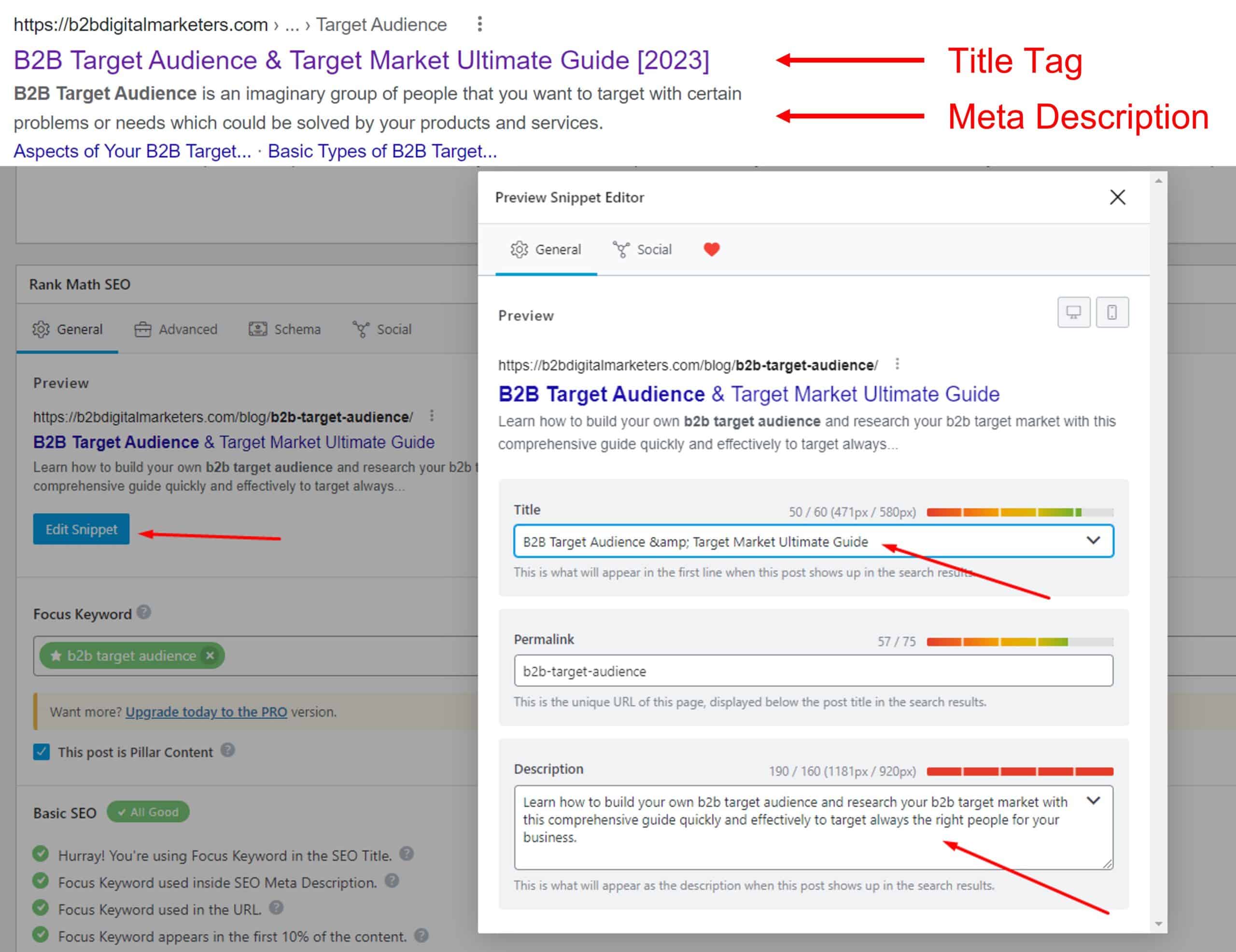
- Target Only One Primary Keyword per Page: Every page should be created specifically for only one primary keyword in order to get the best SEO results and avoid confusing search engines. For example, every of my blog post or pages here is only targeting one keyword just like this article.
- Optimize Your Images for SEO: Images are an important part of your on-page SEO and by installing the image SEO plugin, you manage the technical aspect, but then from an on-page SEO standpoint I recommend you write a descriptive name and alt-text for the image and include your primary keyword (not in every image thou) just like in this example.
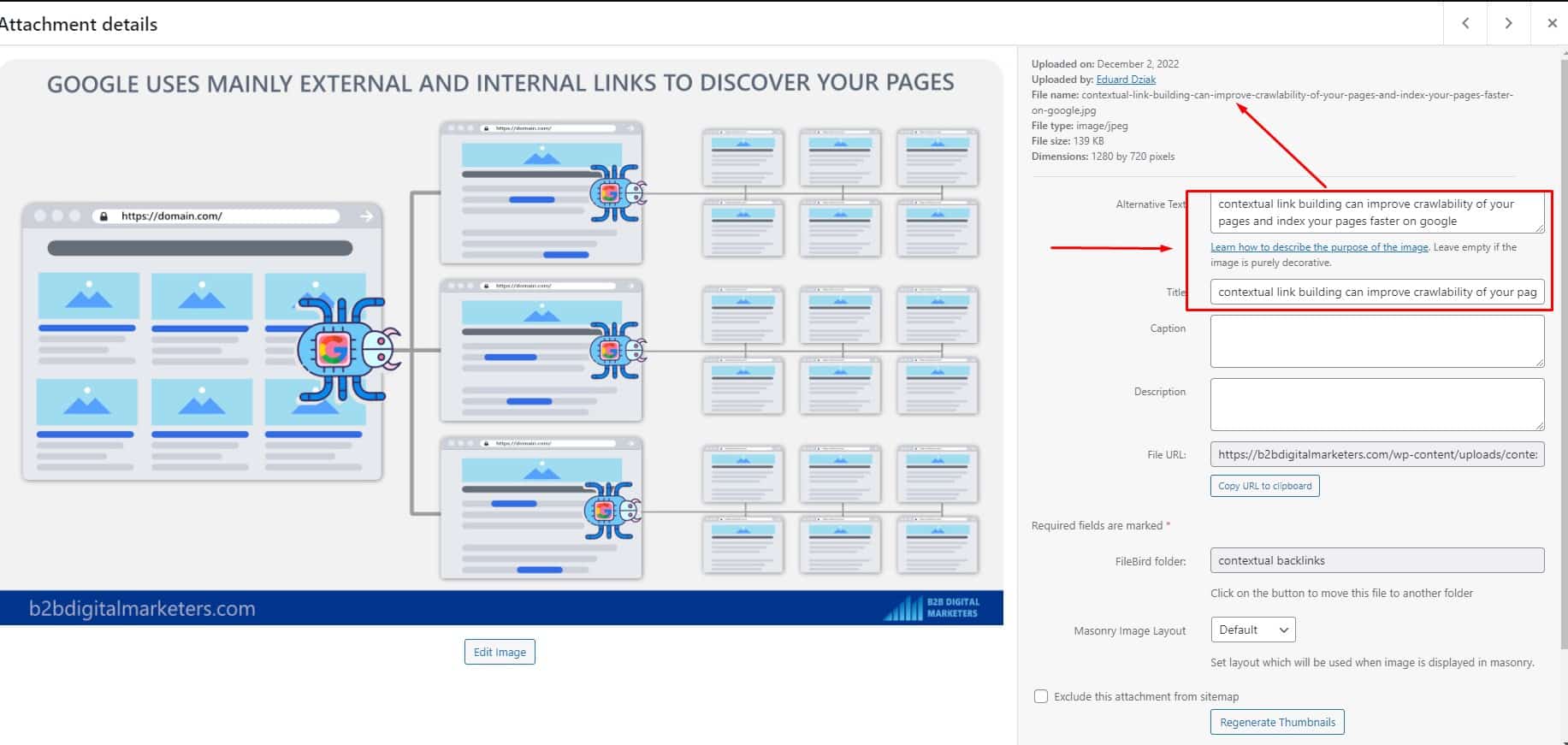
- Create SEO-friendly headlines: SEO headlines will help you to chunk your content into easy-to-read and attractive content and help search engines better understand your content. I recommend you include important primary and secondary keywords as well as important information that your customers often ask you for that topic.
- Create SEO-friendly URL: Include only your primary keyword in your URL and avoid using any dates or numbers within your URLs such as the year or number of tips, tricks, or strategies to create more evergreen URLs. So, you don’t have to create a new article every year or when you add an extra new strategy. For example, look at this URL, what if they add one more secret?

- Think about SEO Website Architecture: This can be a complicated subject but the easiest tip I can give you is to categorize your content in your URL. For example service pages under the service folder, blog under blog posts, products under product category, etc. Here is an example:
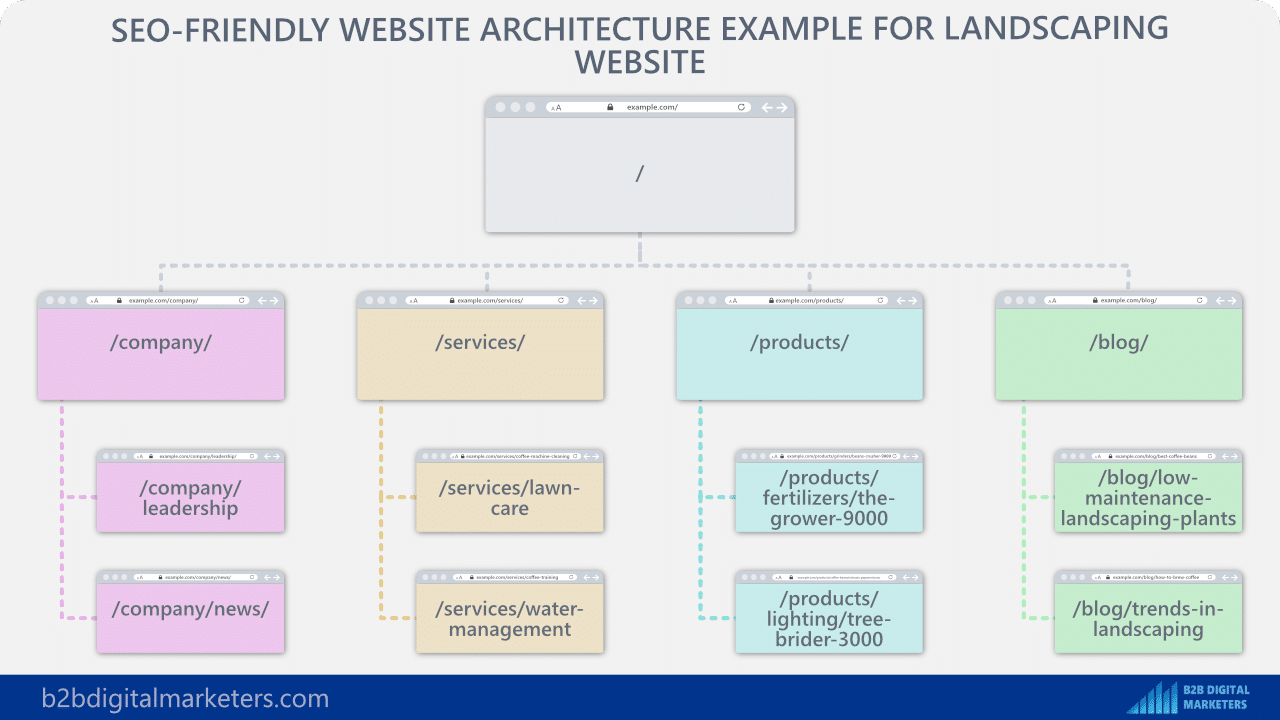
- Optimize for Keyword Placement: According to John Mueller, you should make it easy for Google to understand what’s your page about without keyword stuffing. To do that, I recommend including your primary keywords in titles & meta, headlines, images, introduction text, throughout the content, URL, and H1 tag. Check how and where to add keywords in WordPress.
- Follow SEO plugin Instruction: SEO plugin is like the second pair of your eyes used even by the best SEOs in the world. They give you a useful SEO checklist that you can follow every time you are optimizing content.
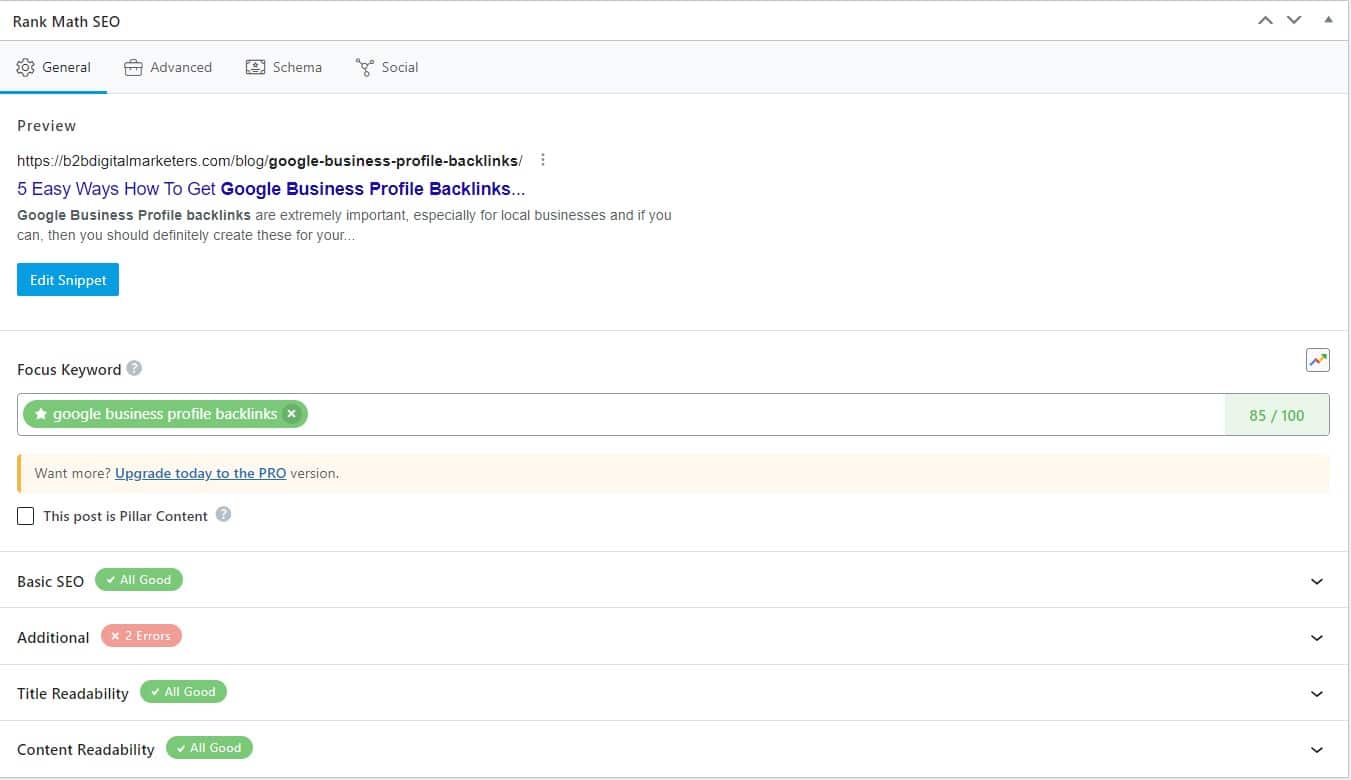
By following these on-page SEO best practices, you can optimize your website’s individual pages for search engines. This includes optimizing the content and HTML source code of each page to make it more relevant, valuable, and easy for search engines to understand and rank.
On-page SEO can help improve the visibility and ranking of your landscape website in search engine results pages and improve your organic click-through rate, leading to more organic traffic and potential customers.
3. Start with Easy to Rank Keywords
The next best practice for SEO for landscaping is to search and target easy-to-rank keywords first before you jump into the juicy and highly profitable keywords.
To begin with, search engines typically do not have much trust in new websites and will not allow them to rank for competitive SEO keywords. As a result, it is necessary to target easier-to-rank keywords in order to drive traffic and establish trust with search engines.
These keywords can be long-tail or shorter and can be found using an SEO tool like SE Ranking. By ranking for these keywords, you can gradually build trust with the search engines and eventually target more competitive keywords.
Once you have an SEO tool, then here is a quick step-by-step keyword research process for easy-to-rank keywords:
Step #1: Find your relevant seed keyword. Seed keywords are general phrases or words relevant to your industry, in your case landscaping, and are used as the starting point for keyword research to generate a list of related keywords. This is an important part of your Blog SEO.
For example, seed keywords that might be used in the landscaping industry are:
- Landscaping
- Lawn care
- Garden design
- Outdoor lighting
- Hardscaping
- Landscape maintenance
- Water features
- Tree care
- Landscape architecture
Step #2: Analyze Your Seed Keywords. Once you have your seed keyword, then you pop it into the SE Ranking Keyword Research Tool, select your target country and click on analyze.
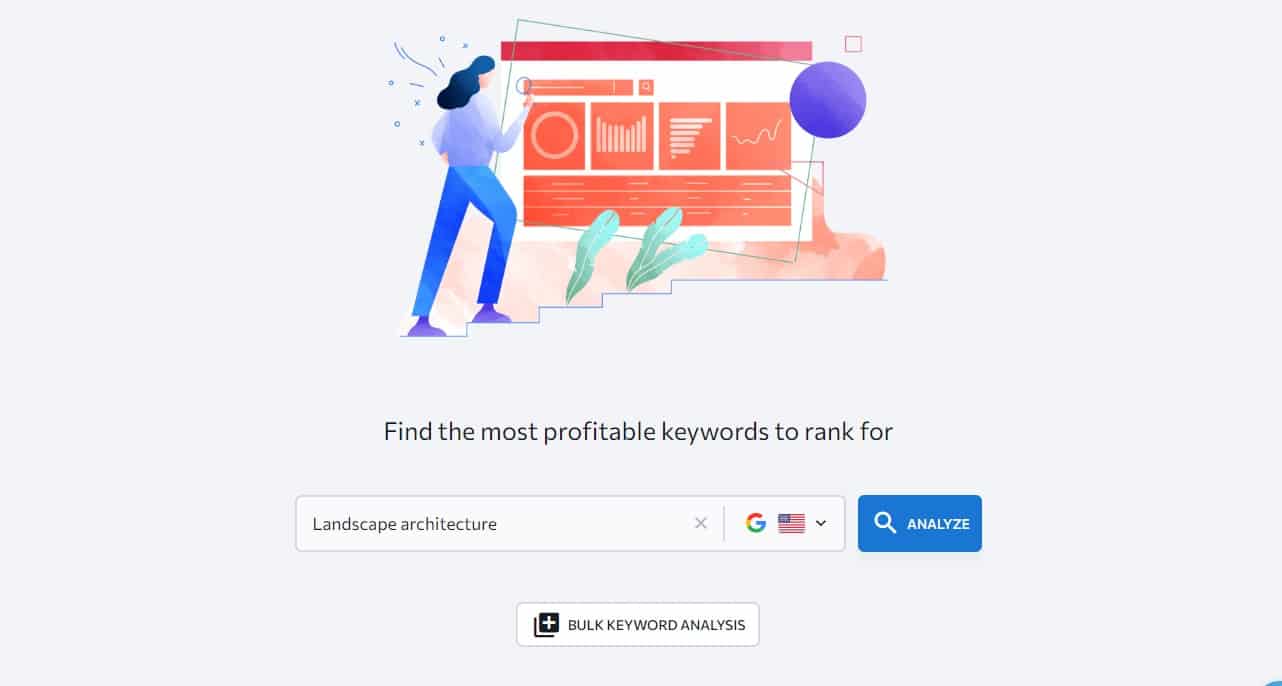
Then you will go to the “Keyword Suggestions” report where you will find relevant keyword ideas for your landscaping industry.

Step #3: Find Easy to Rank Keywords. Once you have the relevant keyword list you will want to find easy-to-rank keywords.
To do that you will primarily look at these four aspects:
- Keyword Difficulty: This is a measure of how difficult it is to rank for a particular keyword. A lower score indicates that it should be easier to rank for the keyword. While this metric can be a good starting point, it should not be the only factor considered when deciding which keywords to target.
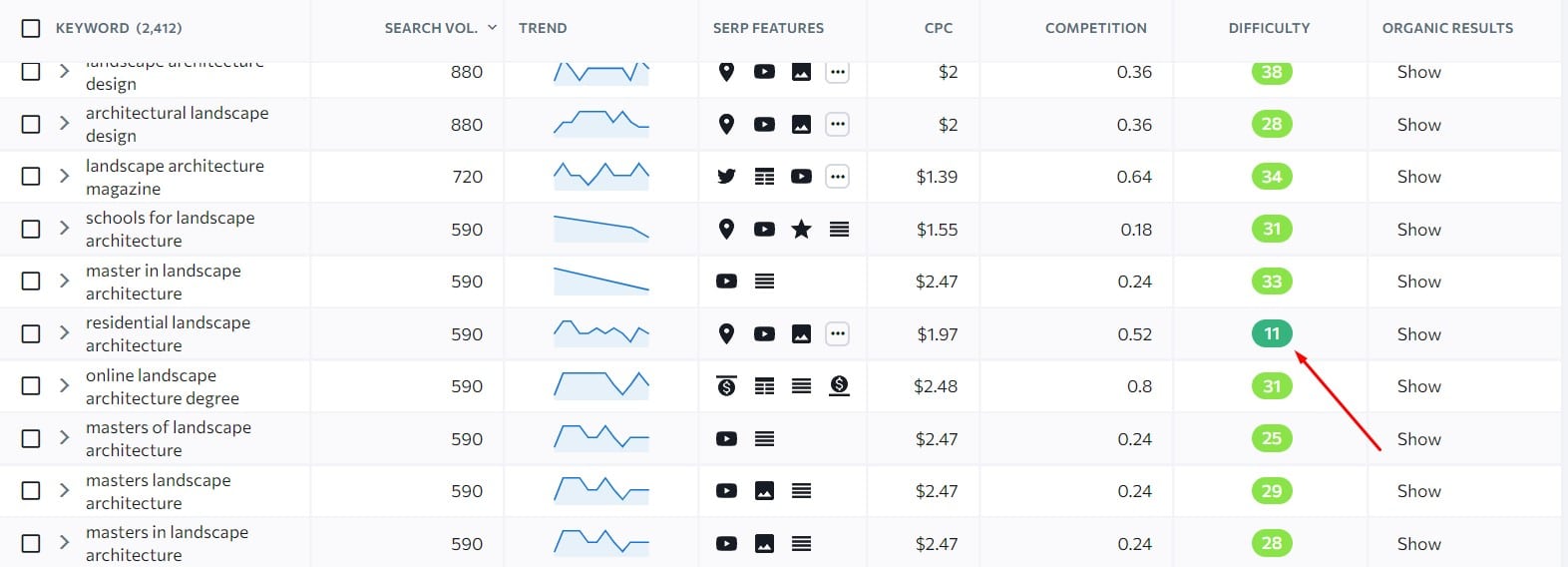
- Who is Ranking for the keyword: After that, you will want to look at who is ranking in the top 10, preferably in the top 5 to see what are your chances to overrank them. Because essentially only these positions matter in terms of bringing organic traffic. If you see only well-known authority domains, you will have a tough time. For example, despite this keyword being only 11 KD, the top-ranking positions are by big websites, and you won’t have a chance to over-rank them.
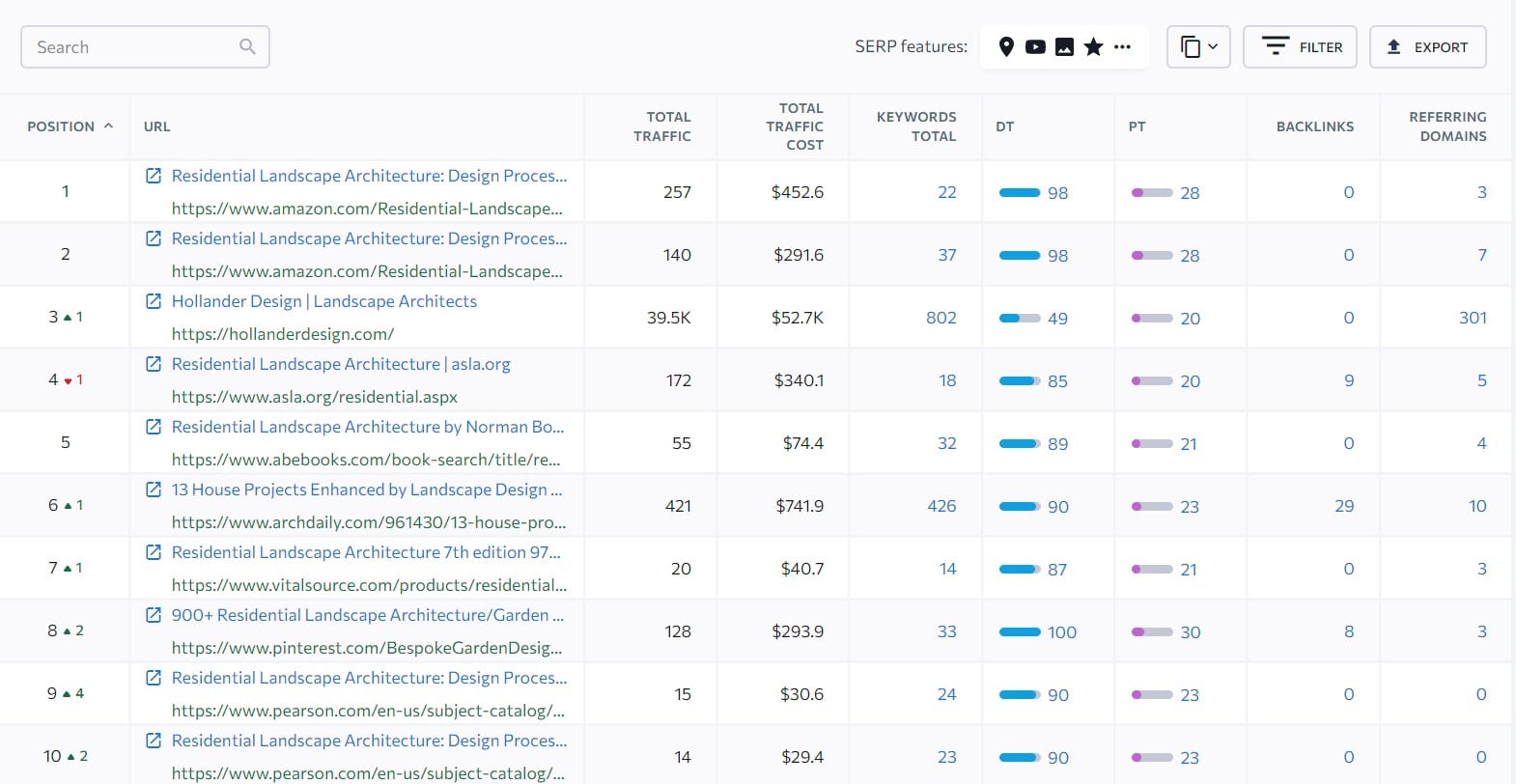
- Page & Domain Trust: You will also want to look at the Domain Trust (DT) and Page Trust (PT) metrics of the top-ranking websites. You essentially want to find websites with lower metrics than yours.
- # of Referring Domains: You also want to check the backlinks and referring domains number as the fewer they have the easier should be for you to outrank them as you will need to build only a few backlinks. But on this a bit later.
- Keyword Volume: Once you have found easy-to-rank keywords, then will want to prioritize the keywords based on the estimated search volume.
This blueprint can help you discover keywords that are relatively easy to rank for, even with a small website. By targeting these keywords, you can start attracting relevant organic traffic more quickly.
Keep in mind, however, that it may take some time to find such keywords, as they are becoming increasingly hard to come by.
4. Create Off-Page SEO for Reputation
The next essential part of SEO for landscaping is to work on your off-page SEO to boost your online reputation.
Off-Page SEO is an essential step in order to gain higher trust from search engines to rank higher in SERPs and also increase your trust from users that are searching for your brand and want to see if you are reputable brands.
With that, there are numerous off-page SEO activities that you can do, but here are the most important:
- Citation building: This is a process of registering your website on relevant directories and business listings as well as the general ones. The most important would be Google Business Profile, Bing for Places, Apple Maps, Yelp, and those relevant to your location. Often there are local and industry-specific directories for your area that you should register yourself.
- Actively collect online reviews: This is arguably one of the most important aspects of building your online brand especially when you are getting started. Therefore, you should actively collect reviews on your business listings, directory listings, and social media.
- Brand mentions: You should actively try to get brand mentions by getting interviewed, providing excellent service so you get recommended, collaborating with others and influencers, or reaching out to bloggers or journalists to provide some interesting news.
- Link Building: Getting backlinks to your website is like getting a vote of confidence from others which is a major Google factor in ranking. Your goal is especially getting niche-relevant backlinks or at least contextual backlinks to bring the best results.
- Be active on social media: Social media are a big part of your target audience’s life and can be an excellent way to grow your visibility and brand name, attract new clients, get social signals, drive more referral traffic, and overall boost your audience engagement and provide better user experience when they are trying to reach you.
Off-page SEO can help to build Google’s perception of your website’s experience, expertise, authority, and trustworthiness, also known as E-E-A-T which is an important factor that Google’s search algorithm uses to determine the quality and relevance of a webpage, and it can have a significant impact on your website’s ranking in search results.
5. Build High-Quality Backlinks for Your Website
The next best strategy for SEO for landscaping is to build high-quality backlinks for your website.
As already said, backlinks are one of the most important ranking factors that determine your ranking, thus, also the business you can bring for yourself.
Therefore, investing in building high-quality backlinks is one of the best ways to grow your SEO lead generation. However, before you do that you must understand what makes high-quality backlinks, here are the 4 most important aspects:
- Website relevance: A high-quality backlink comes from a website that is relevant to your industry or business. For example, if you run a landscaping company, a backlink from a gardening blog would be more valuable than a backlink from a technology blog.
- Content relevance: The content on the website where the backlink appears should also be relevant to your business. For example, a backlink in an article about landscaping techniques would be more valuable than a backlink in an article about solar panel trends.
- Organic traffic: A website with a high amount of organic traffic is typically a more authoritative and trustworthy source, and a backlink from such a website can be more valuable. I recommend using SE Ranking Competitive Research Tool to check the website’s organic traffic. The minimum should be 500, preferably 1,000.
- Website authority: To determine the value of a backlink, you can use SEO tools such as SE Ranking to check the website’s authority. In general, the higher the website’s authority, the more valuable the backlink will be. However, it may be more challenging to acquire backlinks from highly authoritative websites. As a starting point, you may want to focus on websites that have a similar authority level to your own, around +/-10. From there, you can gradually work towards acquiring backlinks from more authoritative websites.
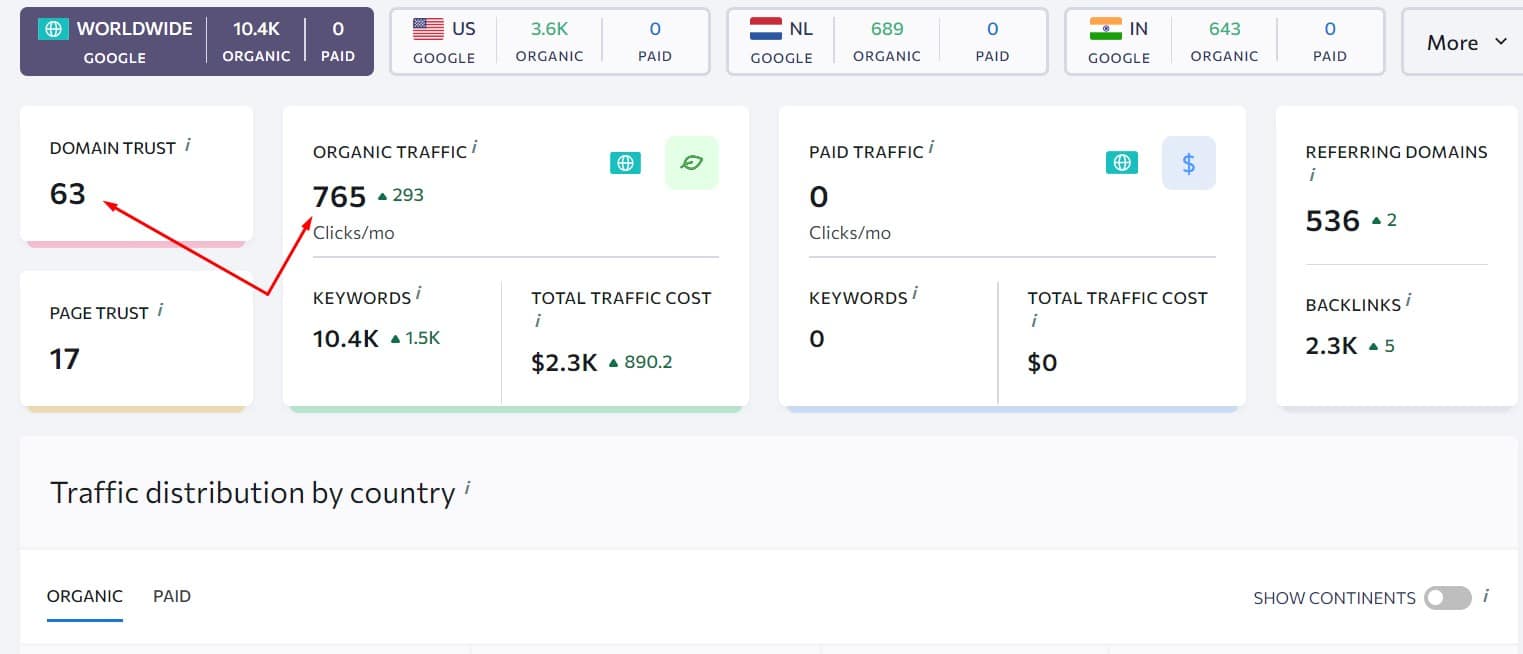
With that being said, if you can invest by getting link building agency, then they will handle it for you, but if you cannot, here are 4 best link-building strategies you can do on your own:
- HARO Link building: You just need to register yourself at their website and you will receive inquiries from journalists you just need to answer those that are relevant to your industry. It’s the most beginner-friendly and least time-consuming link building strategy with possibly great results.
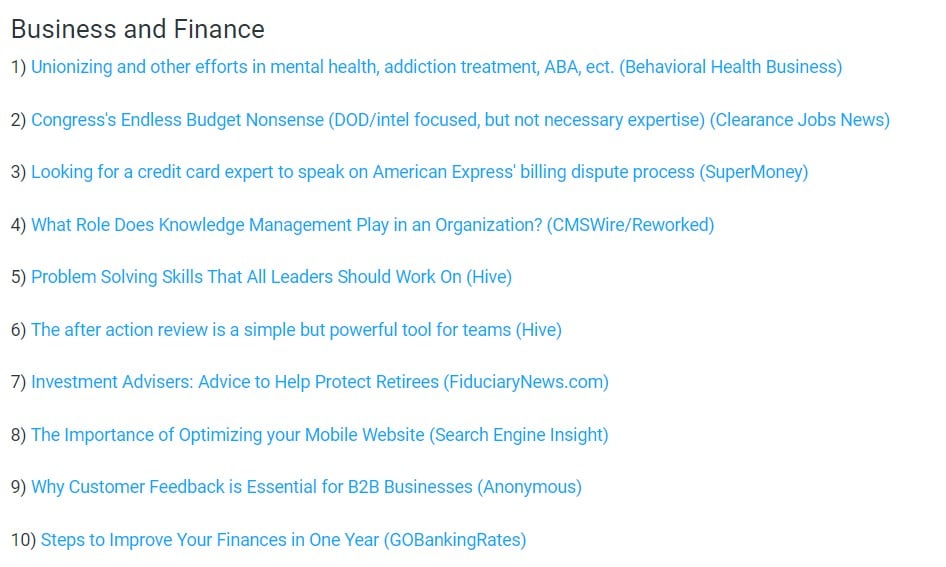
- Resource Page Link Building: This link building strategy involves finding websites with resources or links pages and requesting that they add a link to your website. For example, you could try to get featured on these kinds of pages:

- Guest Posting: This strategy involves writing articles or blog posts for other websites often relevant to your industry, usually in exchange for a backlink to your own website.
- Podcast Link Building: If you are a talkative person, then attending podcasts can be another great way to do link building. To get started, search for popular podcasts in the landscaping industry and try to get invited as a guest. Be sure you can include a link to your website on the podcast host’s website.
Acquiring high-quality backlinks can be a challenging aspect of SEO, and many people neglect it. However, because it is so important and relatively few businesses invest in it, it also presents a great opportunity to generate leads through SEO.
So, if you have the budget, it’s a good idea to allocate at least $500 for link building efforts. This will help you take advantage of the opportunities available and drive more business to your company through SEO.
6. Prioritize Internal Links
The next big part of your SEO strategy for landscaping is to prioritize building internal links to every and from every of your page.
Internal links are arguably the most powerful on-page SEO factor that you have absolute control over, and they can have a huge impact on your ranking and overall, SEO results.
Internal links help to distribute the “link juice” from backlinks throughout your website, improving the ranking of your pages and increasing the chances of generating leads through your most important pages, such as your service or product pages. This can be a powerful way to drive more business for your company.

On top of that Google uses internal links as a prior way to discover new pages.

So, every time you create a new page, you should create relevant internal links from the new page and also to the new page to boost the ranking and speed up the indexing of the new page.
To find opportunities for internal linking, you can use a Google search string like this: site:yourdomain.com “primary keyword”. This will show you any mentions of your primary keyword on your website.
For example, I just published an article on B2B SEO, so I can use this Google string to find where I have mentioned the keyword “b2b seo”, and then add internal links to the new article. This helps to spread link juice and improve the ranking of your pages.
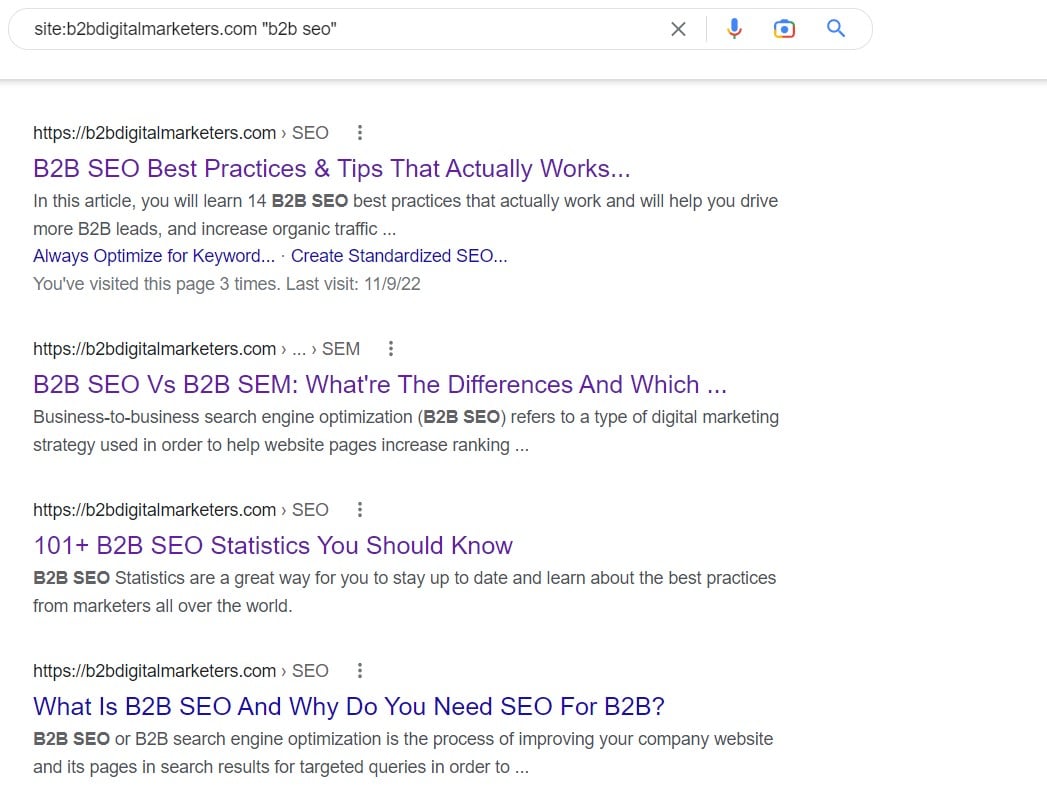
I can also use a WordPress plugin to find internal linking opportunities such as Link Whisper but take it with pinch of salt.
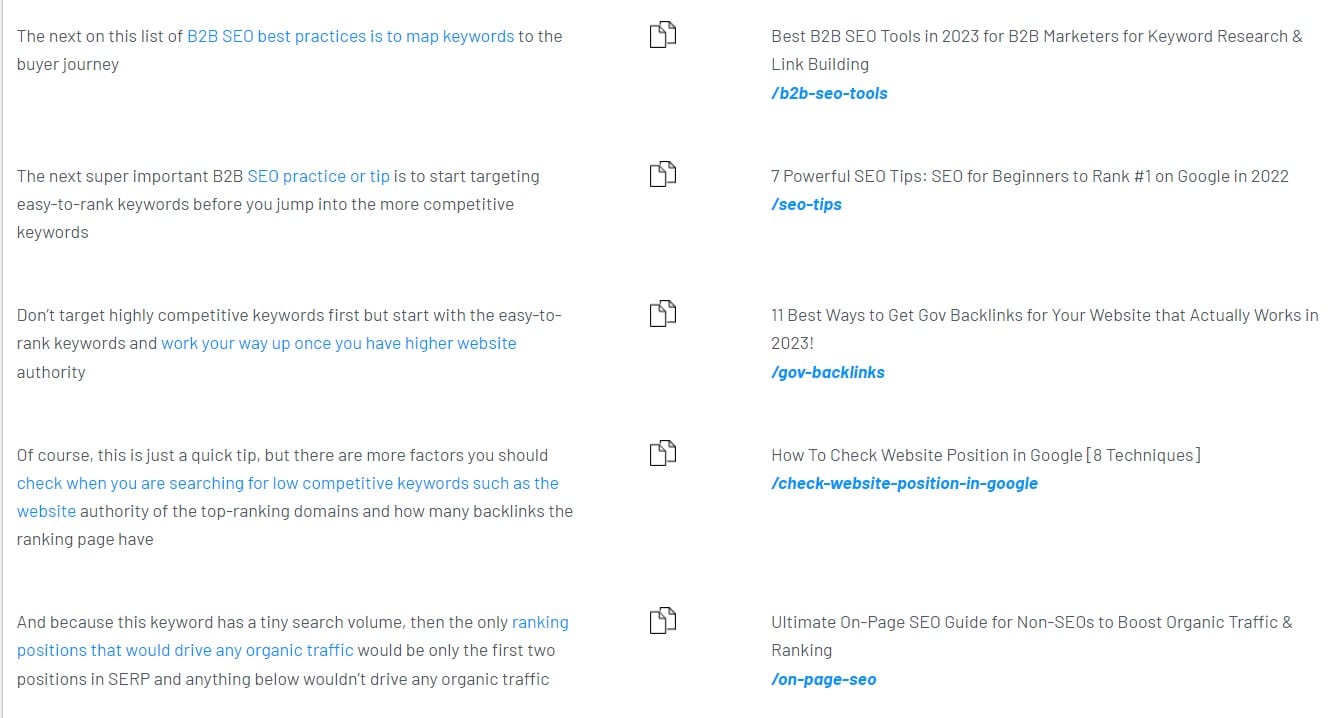
Remember, this is very important to do so, and you should never skip on building internal links for any of your pages!
7. Focus on Topic Clusters
The next best practice is to focus on topic clusters when you are creating content on your website in order to achieve topical authority in SERPs, improve your ranking and build a brand that is trusted by Google and its users.
In the context of search engine optimization (SEO), a topic cluster is a group of related content pages that all center around a specific topic or theme.
The main idea behind using topic clusters is to organize your website’s content in a way that makes it easy for search engines to understand the relationship between different pages and to determine which pages are most relevant for certain keywords which results in improving your semantic SEO.

One way to approach this is to pick the most important or profitable service that your business offers, and then create a cluster of content around that topic.
For example, if your main service is landscape design, then you might create a cluster of content about that by taking the seed keyword “landscape design” and pop in it into SE Ranking Keyword Research tool.
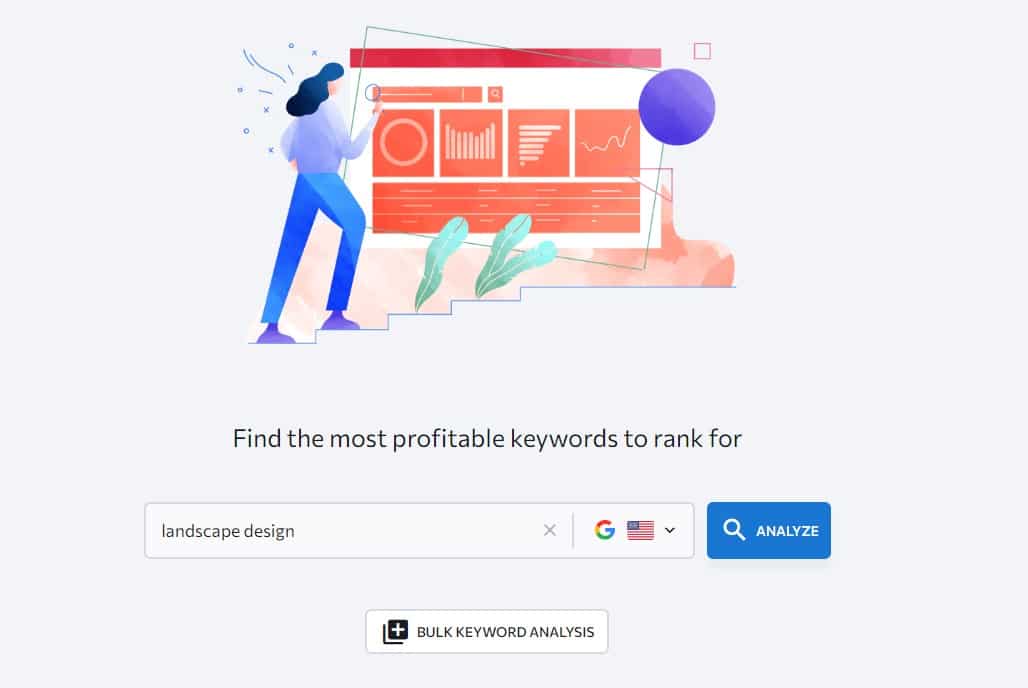
Then you will go to the “Keyword Suggestion” report and pick all the relevant keywords that you can target and start creating content around it.
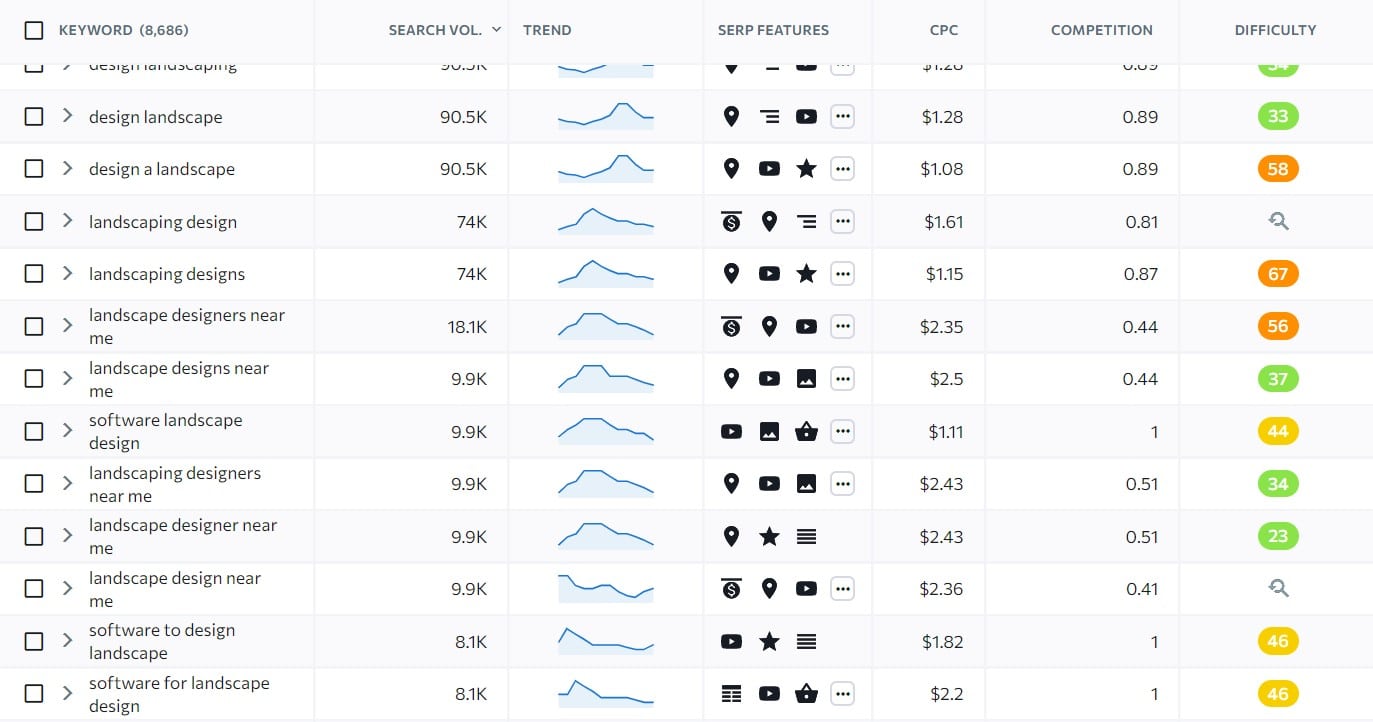
Your goal is to create all types of pages from blog posts to service pages in order to have content across all stages of the buyer journey by covering all the search intent types you can.
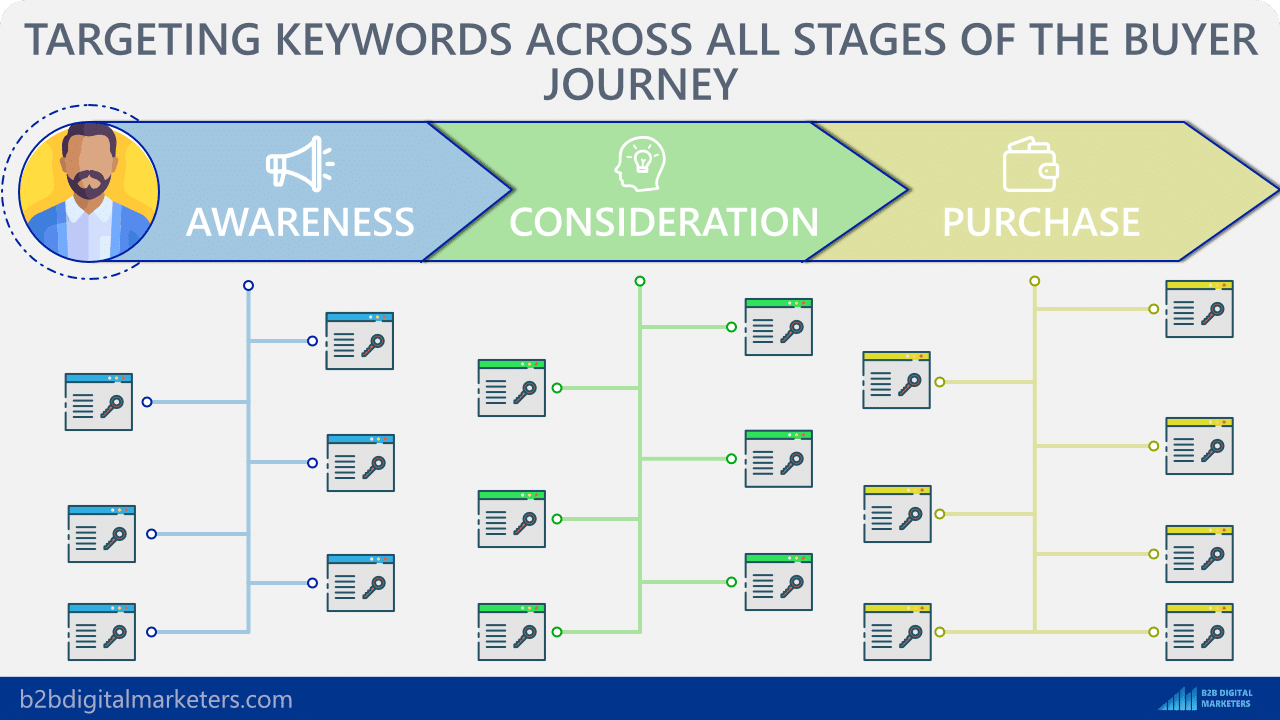
With that here are some example keywords for landscape design that could be used for different types of search intent:
| Informational | Navigational | Commercial | Transactional |
|---|---|---|---|
| Landscape design ideas | Landscape design companies near me | Best landscape design companies | Landscape design cost |
| Landscaping for small yards | Landscape design firms in [city] | Landscape design services comparison | Landscape design pricing |
| Landscape design principles | Landscape design services [city] | Landscape design firms ratings | Affordable landscape design services |
Based on this you will create the right type of content and you will start seeing an increase in users. However, remember you want to first start with easy-to-rank keywords, BUT first be sure to also target “money keywords” (keywords related to profitable services or products) on your service pages.
By focusing on these specific keywords, you may see an increase in users and potentially drive more revenue for your business.
8. Use SEO Tools to Speed Up Work
The next piece of advice I have for you is to start using SEO tools to speed up your work and also improve your results.
Nowadays, to get ahead you need to rely on certain tools, for your financial operation, you need an accounting solution, for your HR you need an HR system, so the same you need for your marketing department as well.
As you could see, having an SEO tool such as SE Ranking can be a vital solution to your SEO success and there are many more tools you can and will use for your SEO. (Check out SpyFu Alternatives)
Other than that, I also want to recommend two types of tools:
SEO Writing Tools: These are important because they can help you optimize your website’s content for search engines and speed up production, which can improve the visibility and ranking of your site in search results.
Email Marketing Tools: These are important because they can help you effectively communicate with your target audience and promote your products or services through email greatly boosting your revenue. (Also check out the best Sendinblue alternatives.)
Investing in your marketing will ensure you will be continually generating leads or sales for your business despite the current political or financial situation in your country and you simply cannot afford to not invest in marketing and the tools to get the best possible results.
9. Prioritize Local SEO
The next strategy for SEO for Landscaping and arguably the most important is to prioritize your effort on Local SEO.
Most likely you are only targeting your target audience in your local area be it a city, district, or region so the best way to do that is by Local SEO and if done wrong it could be the biggest reason why your business is not showing up on Google.
Local SEO helps your business to promote your products or services to local customers in your target locations at the exact time they are looking for them. For example, if you provide landscape design services in a specific city, you want your business to show up when someone searches for “landscape design in [city]” or “landscape design near me”
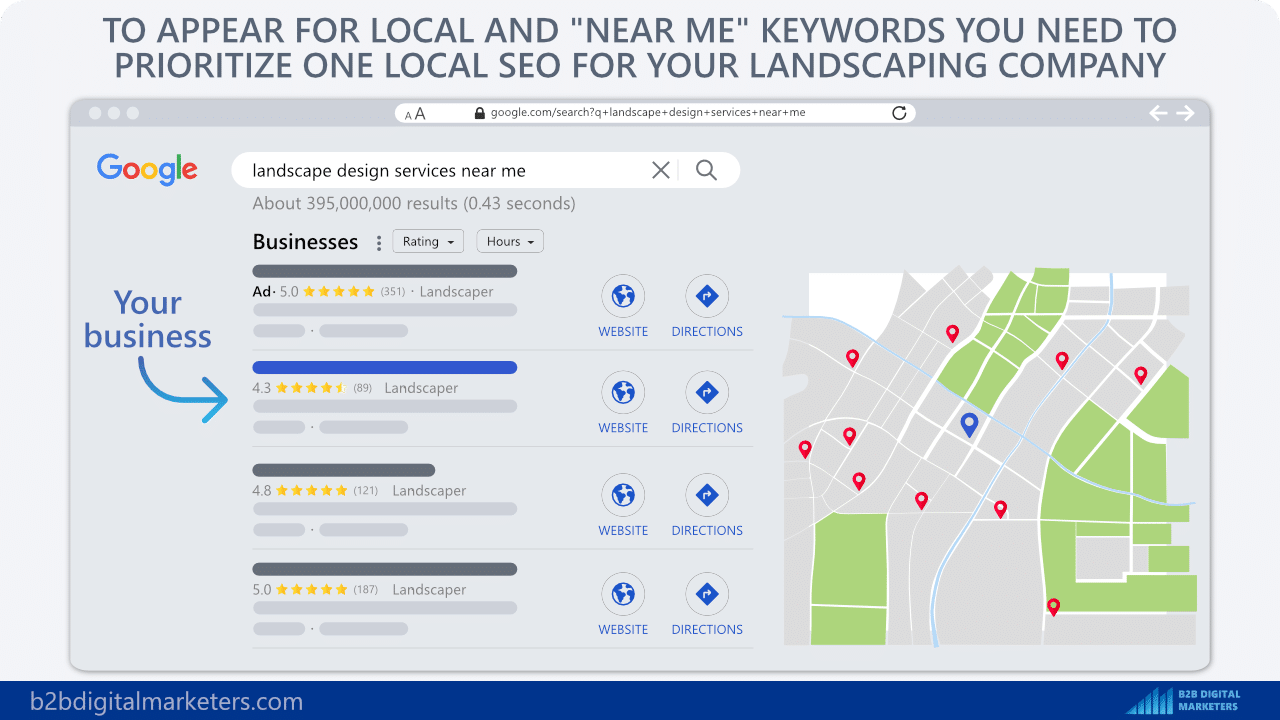
Local SEO is important because it helps your business stand out in a crowded online marketplace. Local SEO is often easier to compete in, as you can focus your limited marketing resources on a specific geographic area, making it more effective.
With that being said, here are some of the most important Local SEO techniques and Local SEO best practices for landscaping you should focus on:
- Create Google Business Profile: Many people in your area are searching on Google for your products or services and to give Google the right information to appear for these search results is by creating well-optimized and maintained GBP.
- Target local keywords: As shown, people will be searching for your products or services with local keywords, but you should also focus on creating location-specific educational content. For example “best landscape flowers in [city]” or “landscape tips in [state]” could be some examples of local keywords you could target.
- Create location-based pages: To maximize your profitability and target the areas with the highest search demand for your products or services, you should create location pages with detailed information about your business’s location, including the address, phone number, and hours of operation and about the specific products or services you offer at that location, as well as any local promotions or events you are hosting.
- Register yourself for locally relevant directories: In addition to Google Business Profile, you should also register for local directories such as Yelp, Yellow Pages, and the Chamber of Commerce. This will help your business show up in local search results and give you an additional platform to interact with potential customers.
- Have consistent NAP: It is essential to have consistent and accurate NAP (name, address, and phone number) information on your website and across all online directories and platforms, as search engines use this information to verify the identity and location of your business. Inconsistent NAP information can confuse search engines and harm your local search rankings. I recommend following the exact format from your GBP.
- Actively collect reviews: As already said, reviews are essential for your business and you should actively collect them from your customers to improve your SEO results. In fact, 88% of consumers trust online reviews as much as personal recommendations.
Overall, Local SEO is crucial for your business as it can drive you the highest quality leads on autopilot in your target area and it is considerably easier to compete. Therefore, Local SEO should be your priority. To learn more you can also check out this article Local SEO for Doctors as the principles are the same.
10. Google Business Profile is Your Best Friend
I have mentioned several times to focus on building up your business listing, but arguably the most important of them all is Google Business Profile (GBP).
This free tool by Google helps your local business to be more easily found online, particularly on Google Maps and Google search when somebody is searching for your products or services enabling you to bring more leads or sales for your business.
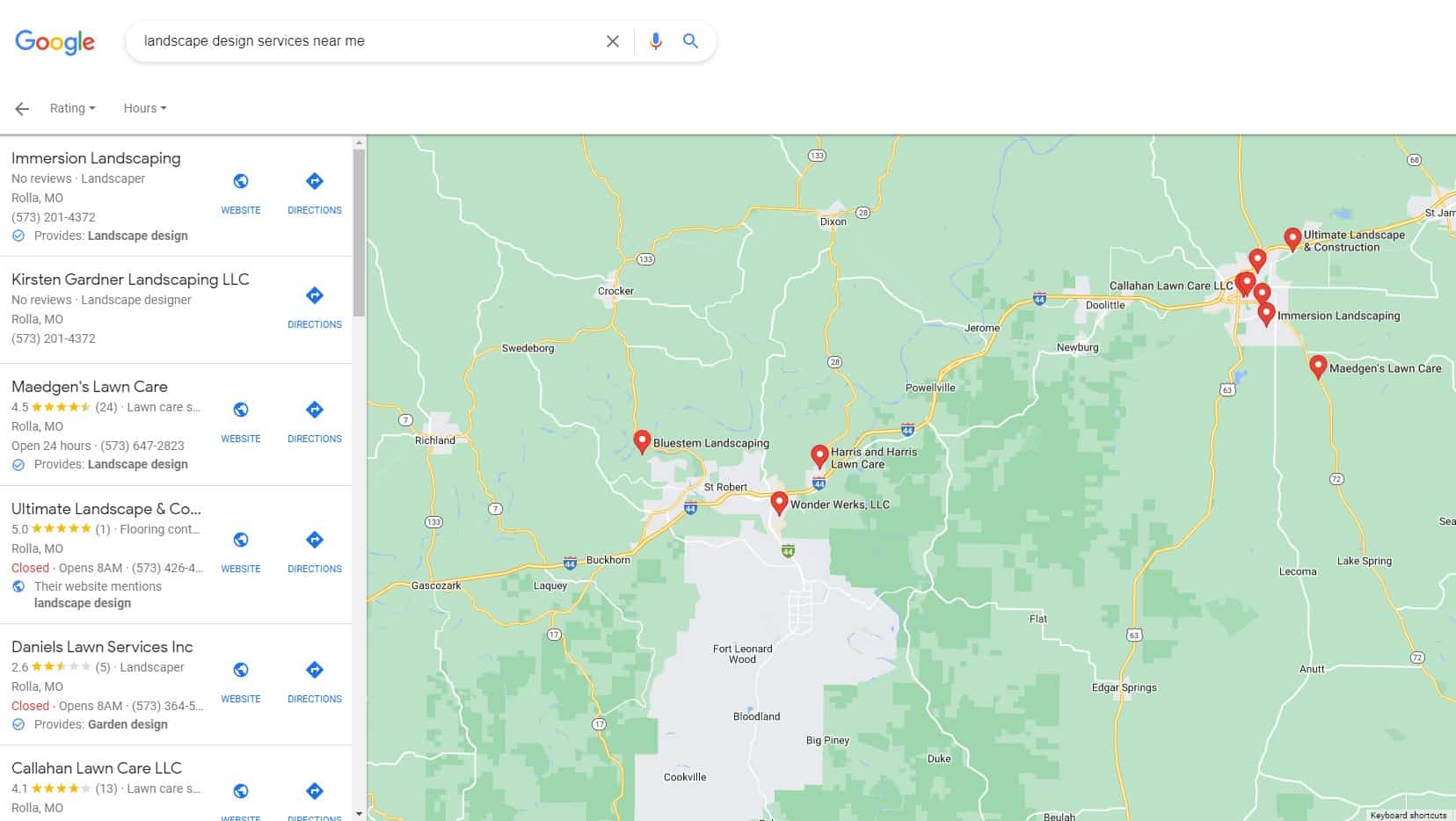
On top of that, it also helps you to better connect with your potential customers, answer their questions, provide useful information to them and even provide any ongoing or upcoming promotions to boost your sales.

Having GBP is essential for every local business and their local SEO as you can help Google to better understand what your business does, and where it is located, which can make it more likely that your business will appear in search results when someone is looking for a business like yours in your area.

With that being said, to make the most of your GBP profile, here are some best practices to follow:
- Claim your business: If your business has been around for a while, there’s a good chance that Google has already created a GBP profile for you. Make sure to claim it so that you can manage how your business is represented online.
- Use important keywords: In your GBP description, categories, posts, reviews, and Q&A, be sure to include relevant keywords that describe your business. This will help Google to understand what your business does and where it is located, which can improve your search ranking.
- Post often: Posts are a great way to inform potential customers about your business and what you have to offer. Including pictures in your listing can also help to attract more attention, with businesses that include photos receiving 42% more requests for driving directions and 35% more click-throughs than those that don’t.
- Collect reviews: It’s important to regularly collect reviews from your customers, as this can help to build trust and credibility with potential customers.
- Ensure 100% accuracy: Make sure to keep all of your business information accurate, as this will help customers to find you and make it more likely that they will choose your business over a competitor.
- Encourage people to post questions: Questions are a great way to boost your GBP listing and local SEO. Encourage customers to ask questions about your business, and be sure to promptly answer any questions that are asked.
- Set up messaging: GBP allows you to communicate with customers through messaging, which can be a convenient way for them to connect with your business and get quick answers to their questions.
- Add backlinks to your website: Linking to your website from your GBP profile can help Google to associate the two and make it easier for customers to find your website when they are searching for your business.
11. Especially Prioritize Local SEO Keywords
I have already talked about Local keywords, but they are so crucial, so I want to talk about them more.
In fact, the following statistics show how important is to optimize for local SEO keywords:
- 37% of searches for something to do result in a purchase (Google)
- 36% of searches for something to buy result in a purchase (Google)
- 18% of local searches for a product or service lead to a sale within one day (Google)
- 17% of searches for a product or service are followed by a phone call (BrightLocal)
And lastly, 46% of all Google searches are local which means there is a huge potential to target local areas.
With that being said, to find local keywords, you can use your seed keyword (as explained in the topic cluster) and then include a “word filter” with your target location within the keyword suggestion report to find only the keywords with the location in it.
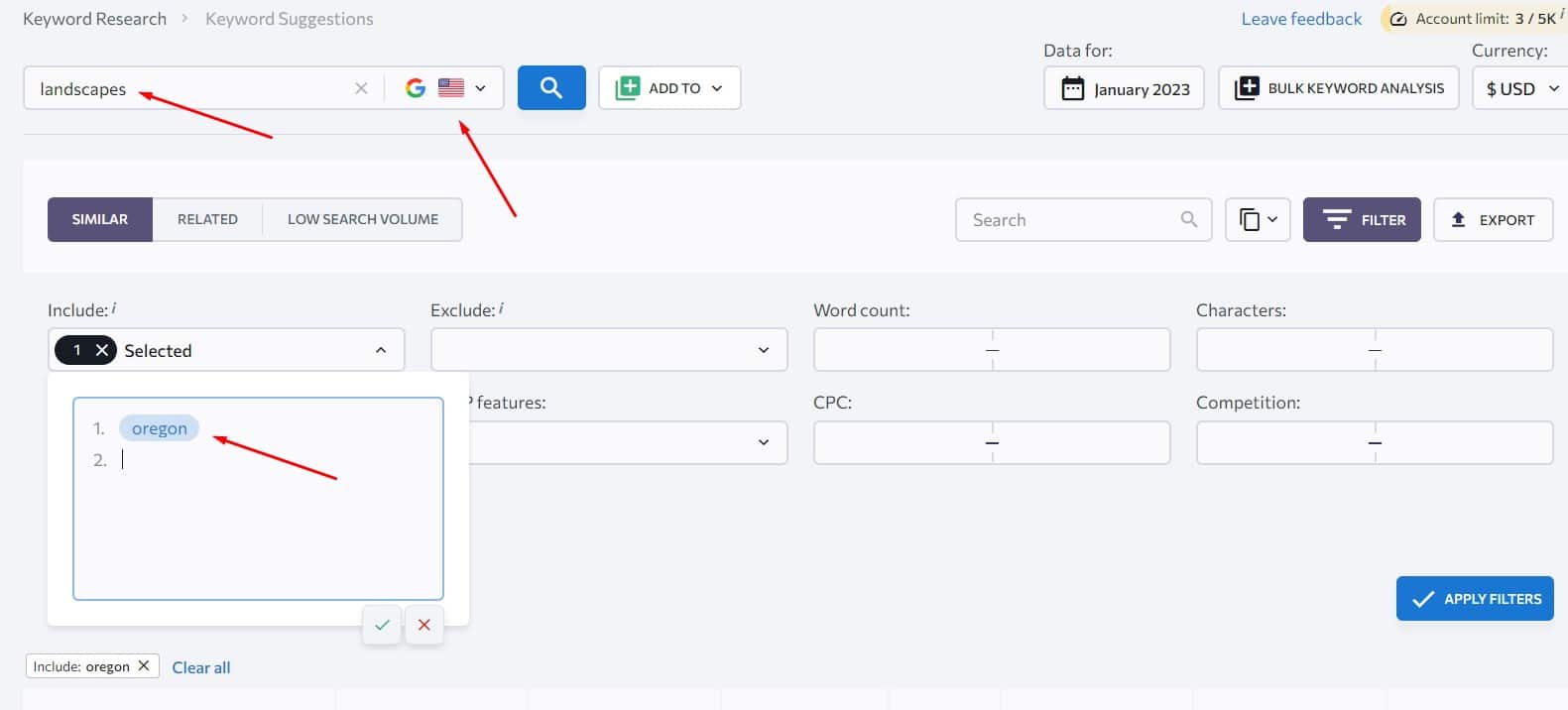
This will show you only the relevant keywords with your location.
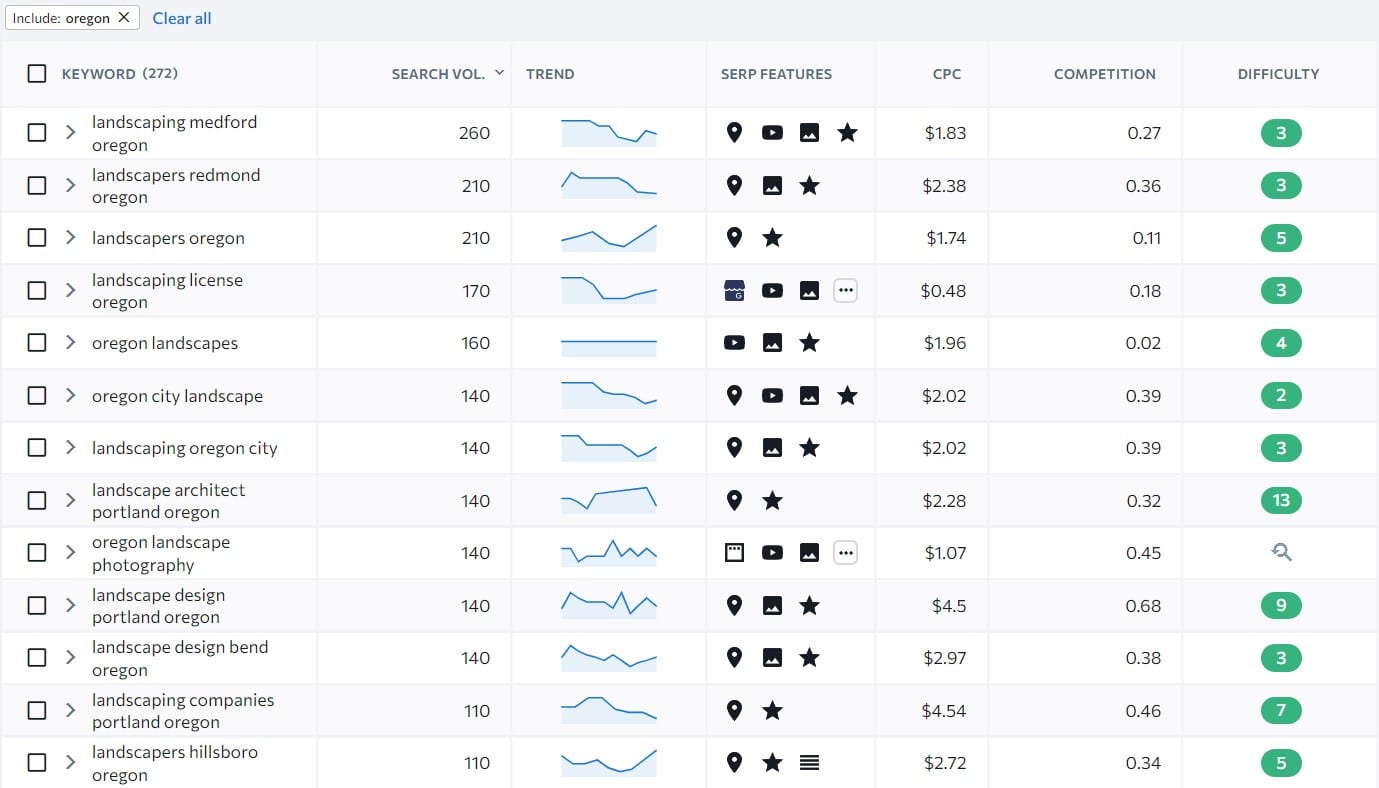
Another way to find local keywords is to localize any relevant but general keywords you found. For example, if you are only targeting Oregon in the US, then you can localize the keyword “cost of landscape design” to “cost of landscape design in Oregon” as those who are searching within that area are more likely to select your article from generic one and it can potentially have better lead generation ability compared to the one without location.
Here are more examples:
| General Keyword | Localized Keyword |
|---|---|
| Landscape design | Landscape design in [city name] |
| Lawn care | Lawn care in [city name] |
| Tree care | Tree care in [city name] |
| Hardscaping techniques | Hardscaping techniques [city name] |
| Lawn maintenance schedule | Lawn maintenance schedule [city name] |
| Lawn care tips | Lawn care tips [city name] |
| Hardscaping estimates | Hardscaping estimates [city name] |
| Lawn maintenance cost | Lawn maintenance cost [city name] |
And the last idea of how you can find local keywords is by doing SEO competitor research analysis. Just pop one of your top competitors in your area in the SE Ranking Competitive Research tool and check out their ranking keywords for inspiration.
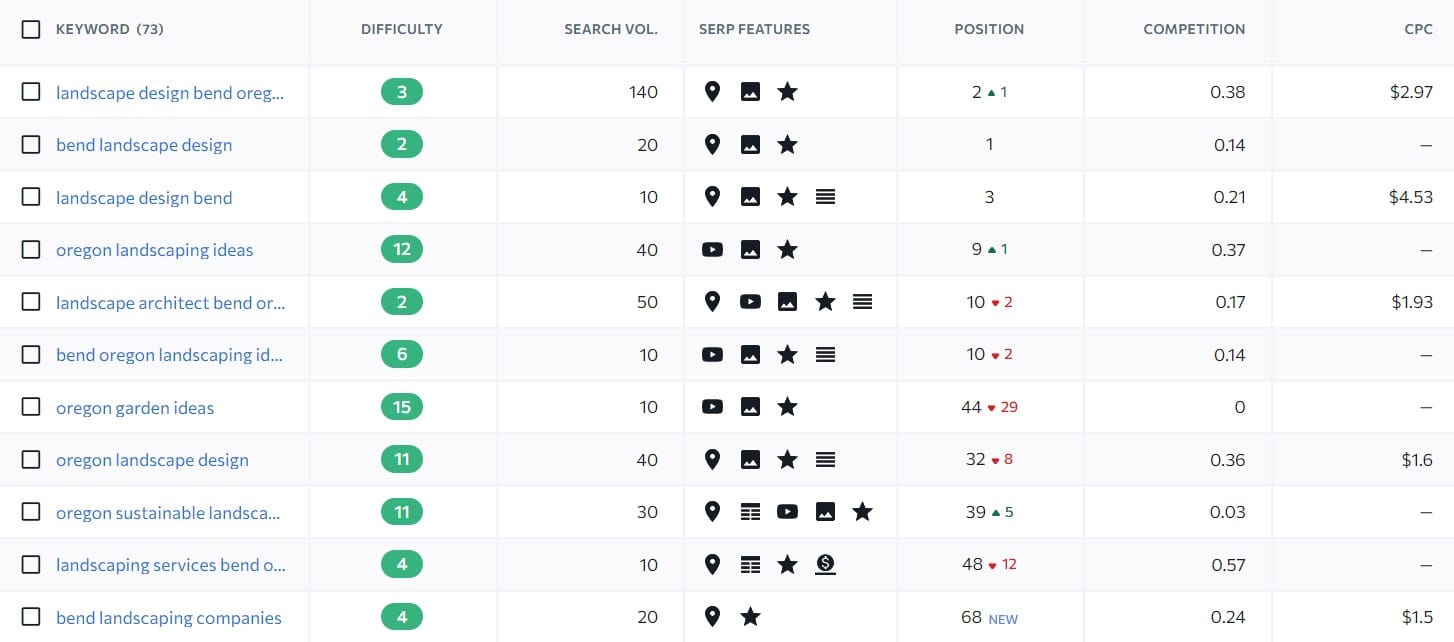
12. Focus on Building E-E-A-T
And the very last best practice I have for you is to focus on building E-E-A-T which stands for Experience, Expertise, Authoritativeness, and Trustworthiness.
Google is flooded with low-quality, uninspiring content that is often created by freelancers or generated by artificial intelligence. In order to continue fulfilling its mission of making the world’s information universally accessible and useful, Google now prioritizes high-quality, expert-written content in its search results.
This means if you want to rank well in Google search results should be focusing on creating and publishing informative, useful, and well-written content.
With that here are some of the best practices to establish E-E-A-T for your website:
- Provide accurate and truthful information.
- Build High-Quality backlinks.
- Get featured as an expert.
- Keep content accurate and up to date.
- Get more reviews for your business.
- Let only experts within your industry write content for you.
- Showcase your credentials such as years of experience, awards, customer testimonials, certifications, or education, etc.
- Let your contact information be easily found.
- Get a Wikipedia page.
- Have real authors on your website for your articles with proper bios and social media links.
- Keep your average ranking position better than 25.
- Create your own custom images and graphics.
- Secure your website with SSL and security plugins.
- Include information about your team and company.
- Regularly update your website.
With that being said, you might not be able to apply all these best practices but start with those you can easily create and slowly work your way up.
Final Words for SEO for Landscape
SEO can be a great source of leads and business for your landscaping business, but it’s important to remember that it’s a long-term game.
It takes time and effort to build up your visibility in search results and establish your business as a trusted and authoritative source of information and services in your local area.
However, the rewards of SEO can be well worth it, as a strong online presence can help to attract new customers and grow your business over time.
By continuously working on your SEO efforts, you can help to build a strong online presence for your landscaping business that will attract new customers and help your business grow over time.
Frequently Ask Questions
SEO for landscaping is a set of techniques and strategies that help landscaping businesses improve their visibility in search results and drive more leads and sales. These techniques can include keyword research, website optimization, and the use of schema markup, among others.
The goal of SEO for landscaping is to make it easier for potential customers to find your business when they search for landscaping services in your local area. While SEO practices can be tailored to the needs of your landscaping business, Google’s algorithms do not specifically favor any particular industry.
Yes, in some industries, known as YMYL (Your Money or Your Life) industries, Google requires more information or trust signals from websites in order to rank highly in search results. In these cases, Google is more careful about whom they rank in order to protect users. However, in general, there is no specific algorithm that would make certain SEO techniques more effective for a specific industry. Instead, SEO techniques can be customized and tailored to fit the needs of any business in any industry.
SEO can help a landscaping business improve visibility in search results, stand out from the local competition, and attract more leads and sales. It is a cost-effective way to drive traffic to a website and can be enhanced by optimizing for relevant keywords and managing online reviews to build trust with potential customers.
These are the common types of SEO you should focus on:
- On-page SEO: This involves optimizing the content and structure of your website to make it more attractive to search engines and users.
- Local SEO: This involves optimizing your website and online presence for local search terms and signals, such as your location and online reviews.
- SEO Content: This involves creating and promoting high-quality, relevant content to attract and engage potential customers.
- Link building: This involves acquiring high-quality backlinks from other websites to improve the authority and credibility of your website.
- Technical SEO: This involves optimizing the technical aspects of your website, such as site speed and mobile responsiveness, to make it more attractive to search engines.
Related Articles:
Also, check out our SEO hub page to find all our SEO resources.
Disclaimer
Some of my links are affiliate links, which means if you purchase something, I might get a small commission as a reward for reference. Of course, I am actively using all these services and products, and I only affiliate products or services I have full trust in their quality!

Source link


